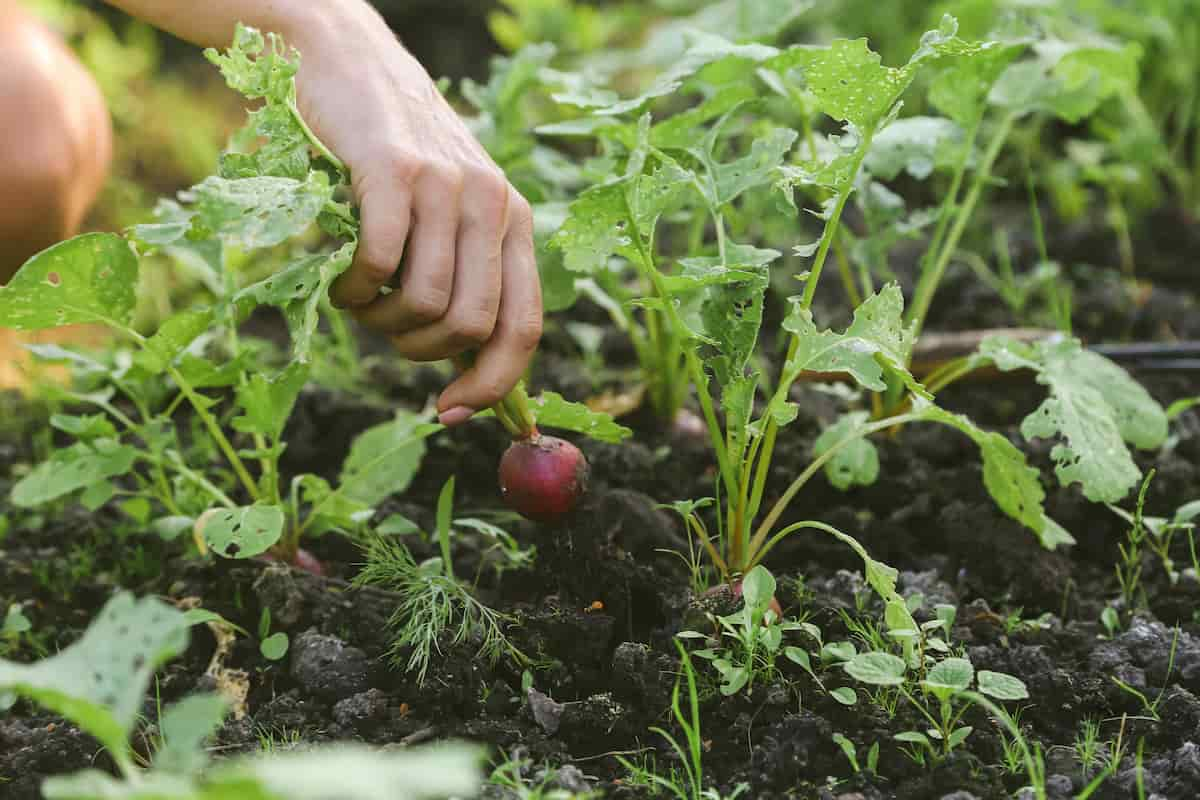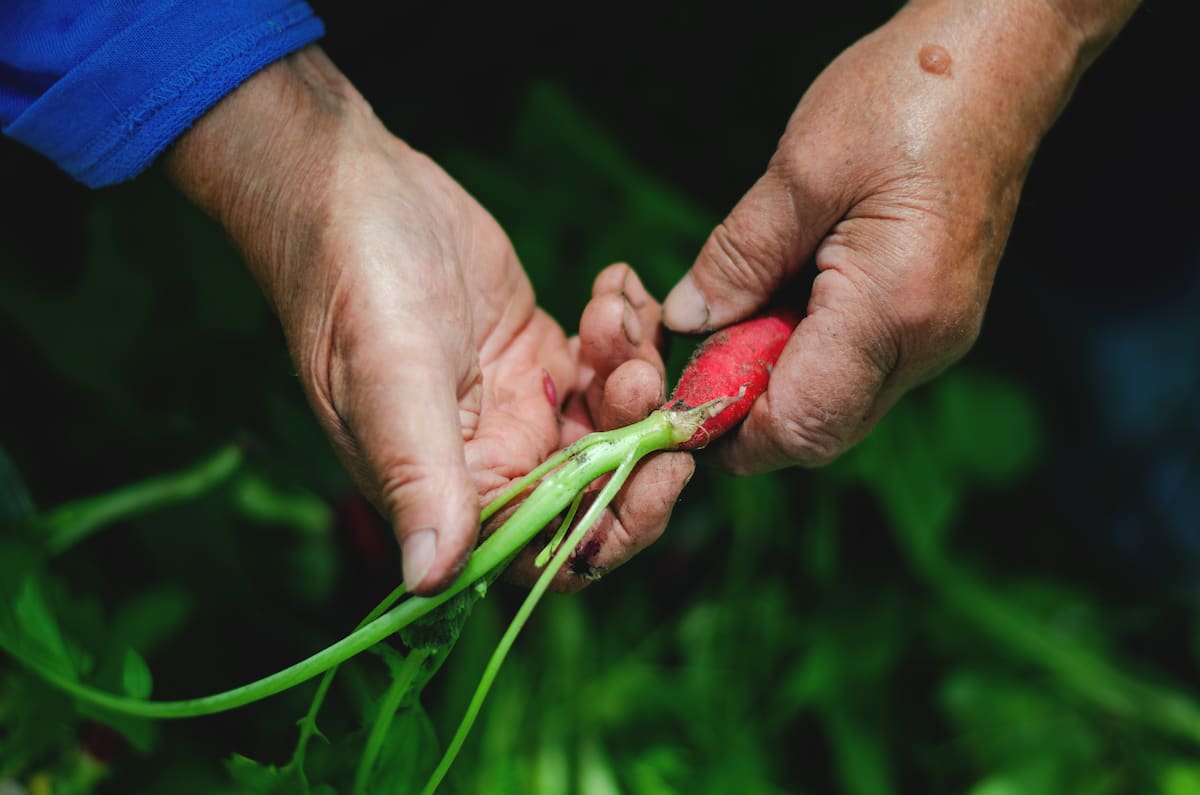The size of a pinhead, aphids are tiny insects that feed on plant sap. They belong to the family Aphididae, order Homoptera, and are known as plant lice, greenflies, or ant cows. Most species have cornicles on their abdomen. Aphids can cause significant damage to plants by stunting growth, producing plant galls, transmitting plant viruses, and deforming leaves, buds, and flowers.

Management of Aphids in Radish
The Life Cycle of Aphids
- Eggs: In some species of aphids, reproduction occurs in the fall or winter, and females lay eggs that will overwinter on perennial plants. In other species, an adult females give birth to live young without mating. These young aphids are called nymphs and do not hatch from eggs.
- Nymphs are immature aphids that emerge from their mother’s body and go through several molts, shedding their skin as they grow. The number of molts varies by species, but most aphids molt four times before becoming adults.
- Winged forms: Some species of aphids produce winged forms in response to environmental cues such as crowding or food scarcity. Winged aphids can fly to new plants or habitats, spreading the population and potentially avoiding predators or adverse conditions.
- Adults: Adult aphids are in the reproductive stage of the life cycle. They are typically wingless and feed on plant sap with specialized mouthparts, piercing the plant’s tissue and sucking out the fluid. Adult females can give birth to live young without mating, producing up to 12 offspring per day. They can continue to reproduce throughout the year, leading to rapid population growth in favorable conditions.
Identification of Aphids in Radish Field
- Look for small, soft-bodied insects in the radish plant.
- Aphids are typically green, yellow, or brown.
- Aphids have pear-shaped bodies and are about 1/8 inch long.
- Look for two cornicles, or tail pipes, at the end of their abdomen, which can be seen with a magnifying glass.
- Look for white cast skins left behind as aphids molt and grow, which can be found on the leaves of the radish plant or stuck in honeydew secretions.
- Take action to control the population of aphids using insecticidal soaps, introducing natural predators like ladybugs, or washing the plants with a strong stream of water.
Factors Favoring Population Growth in Aphids in the Field
- Optimal temperatures for aphid development in radishes are between 20 and 25 °C.
- Upper limits for temperature range from 25 to 30 °C.
- Temperature directly affects the rate of aphid development.
- Extreme temperatures can negatively impact aphid populations.
- Temperature fluctuations outside the optimal range can significantly impact aphid populations in radishes.
- Monitoring and controlling temperature is important for managing aphids and ensuring healthy plant growth.
Damage Symptoms of Aphids in Radish
- Aphids remove sap from the host plant, which can cause the plant to wilt and weaken over time.
- Salivary enzymes injected by aphids during feeding can clog the vascular system of the radish plant or cause injury to the surrounding tissue.
- These injuries can lead to yellowing spots on the radish leaves, distorted growth, and even tissue death or necrosis.
- Severely damaged foliage may fall from the radish plant, reducing its aesthetic value and making it unsaleable.
- Infestations of aphids can also stunt the growth of radish plants, reducing their yield and overall quality.
- Aphid damage can create opportunities for secondary infections by fungi or bacteria that can further harm the radish plant.
In case you missed it: Management of Cutworm in Radish: Symptoms, Treatment, Chemical, Biological, Natural, and Organic Control

Management of Aphids in Radish by Cultural Method
- Crop rotation: break the lifecycle of pests and diseases with non-brassica crops.
- Resistant varieties: reduce chemical interventions and damage caused by pests and diseases.
- Tillage practice: reduce pest and disease pressure with deep or shallow tillage.
- Regular weeding: control weeds and reduce pest and disease pressure.
- Following: reduce pest and disease pressure and allow for soil organic matter build-up.
- Timeless planting: avoid prevalent pests and diseases by Planting at the right time.
- Uprooting and burning infected crops: prevent the spread of soil-borne diseases like clubroot.
Management of Aphids in Radish by Biological Method
- Aphid control in gardens without broad-spectrum pesticides can rely on natural enemies.
- Parasitic wasps deposit eggs within aphids, turning the skin crusty and golden brown.
- The aphid population may greatly decrease within a week or two after mummies appear on plants.
- Aphids are consumed by predators such as lady beetles, lacewings, soldier beetles, and syrphid fly larvae.
- Natural predators are ideal for garden and landscape environments.
Management of Aphids in Radish by Chemical Method
- Monocrotophos or Malathion can be sprayed at 10-15 day intervals to effectively control aphid populations in radish fields.
- These pesticides work by interfering with the nervous system of the aphids, causing them to become paralyzed and die.
- It is important to follow the instructions on the label to safely and effectively use these pesticides.
- It is important to note that these pesticides are broad-spectrum and can harm beneficial insects and other organisms in the ecosystem.
- To prevent the recurrence of the pest, granular insecticides like Phorate can be applied to the soil.
- Phorate works by preventing the development of aphid larvae in the soil, reducing the number of aphids that emerge to infest radish plants.
Management of Aphids in Radish by Organic/Natural Method
- Companion planting: Planting herbs and flowers such as basil, marigold, and chives near radish can help to repel aphids and attract beneficial insects such as ladybugs and lacewings, which prey on aphids.
- Neem oil spray: Mix neem oil with water according to the instructions on the bottle and spray it on the radish plants. Neem oil can repel and kill aphids.
- Garlic spray: Crush a few garlic cloves and mix them with water. Allow the mixture for a few hours, strain it, and spray it on the radish plants. Garlic has natural insecticidal properties that can repel aphids.
- Pyrethrin spray: Pyrethrin is a natural insecticide derived from chrysanthemum flowers. Mix it with water according to the instructions on the bottle and spray it on the radish plants to kill aphids.
Preventive Measures for Control of Aphids
- Members of the onion family, such as flowering onions, garlic, and chives, produce a smell that aphids dislike.Planting these vegetables throughout your garden can help discourage aphids from infesting your crops.
- Avoid Over-fertilizing your plants can create high nitrogen levels, which aphids love to feed on.
- Avoid soft, lush growth in plants which attracts aphids.
In case you missed it: Flea Beetles Management in Radish: Symptoms, Treatment, Chemical, Biological, Natural, and Organic Control

Conclusion
Aphids are prevalent in radish farming, and their infestations can cause severe crop damage. However, many efficient strategies exist for controlling aphid numbers in radish plants. Cultural measures like reducing aphid sources, cutting out affected regions, and utilizing reflective mulches are examples.
Chemical control can also be effective but must be used cautiously and under the label recommendations. Furthermore, planting members of the onion family can assist in dissuading aphids, while avoiding over-fertilization can help to prevent the lush growth that aphids prefer. Farmers and gardeners can successfully manage and avoid aphid infestations in radish crops using these approaches.
- Deworming Schedule for Dogs/Puppies: A Beginners Guide
- How to Prevent and Control Parasites in Goats
- Beneficial Insects in Pest Management
- Natural Solutions for Pest Control in Flower Gardens
- Types of Fungicides Used in Agriculture
- Common Issues in the Fruit Development Stage of Pomegranate Farming
- Fruit Development Issues in Papaya: Easy Solutions and Treatment
- Soil-Borne Diseases and How to Protect Your Plants
- Practices to Prevent Disease Spread in the Garden